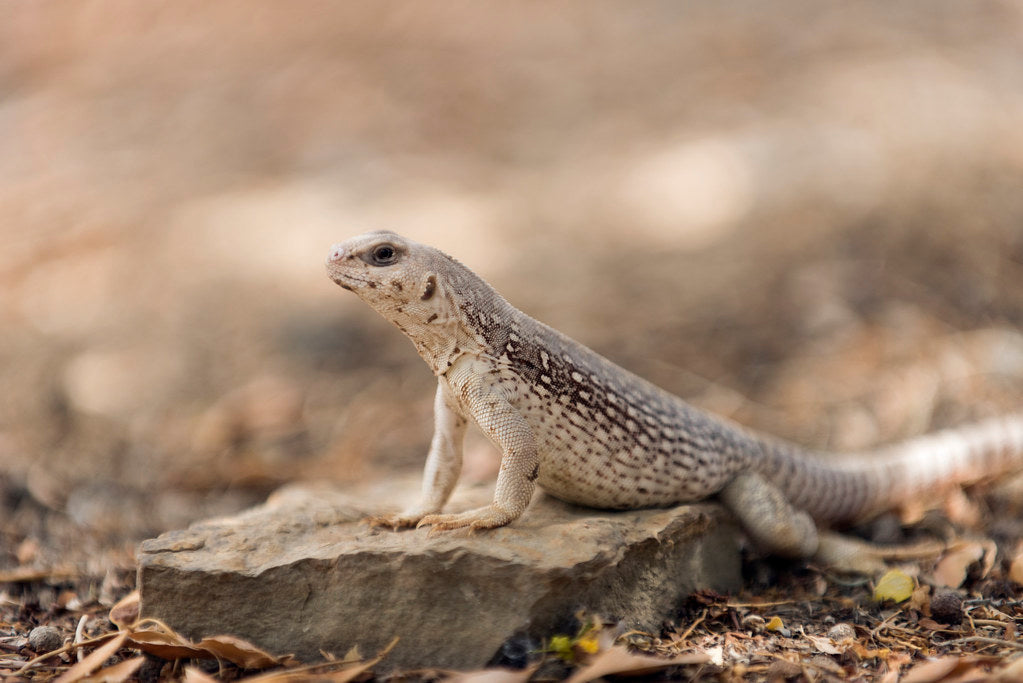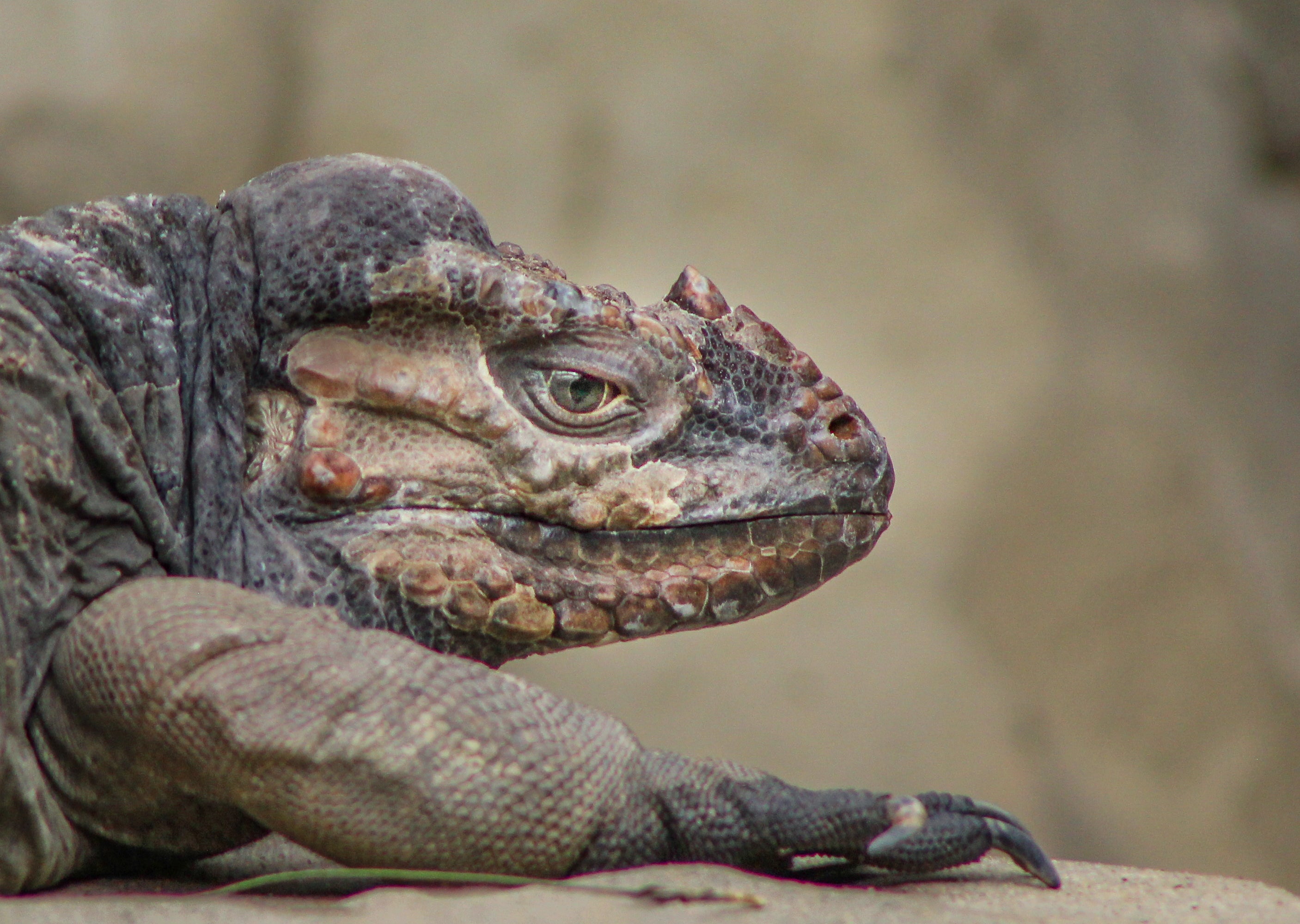Spiny-tailed iguanas (Ctenosaura sp.) are a group of semi-arboreal lizards native to Mexico and Central America. They prefer hot, dry habitats such as tropical dry forest and deserts, but they can also be found on beaches and rockland.
As a group, spiny-tailed iguanas are quite diverse, ranging in size from 10” long all the way up to 4’ long. Appearance varies based on specific species, but they all have tails with noteworthy spines down their length.
Specific care information varies slightly from species to species, but this care sheet should provide a good starting point for the most common ones: C. quinquecarinata, C. similis, and C. pectinata. Because their husbandry is less well-known and they can require large enclosures, spiny-tailed iguanas are intermediate- to advanced-level pet reptiles.
How much space do spiny-tailed iguanas need?
The size of the enclosure will vary based on the expected adult size of your iguana. If you have a C. similis or C. pectinata, then your iguana will need no smaller than a 8’L x 4’W x 4’H enclosure. If you have a C. quinquecarinata, then smaller is suitable — at least 36”L x 18”W x 36”H. If at all possible, larger is strongly recommended.
Cohabitation (keeping multiple iguanas in the same enclosure) is not recommended.
Do spiny-tailed iguanas need UVB?
Iguanas require UVB lighting as part of their captive setup. Aside from helping provide a day/night cycle and providing an infinite supply of vitamin D, UVB is also good for the lizard’s overall health.
Here are the best UVB bulbs for spiny-tailed iguanas:
- Arcadia Desert 12%
- Zoo Med Reptisun T5 HO 10.0
If your iguana is housed outdoors in an appropriate climate, supplementary UVB is not likely to be necessary.
Your UVB lamp should be half the enclosure length, mounted inside the enclosure, and positioned on the warm side of the setup (C. quinquecarinata setups can have the UVB on top of the enclosure rather than inside). Place the basking platform so your iguana’s back will be 17-18” below the lamp. The UVB bulb should be housed in a reflective fixture like the Arcadia ProT5 or Vivarium Electronics. Make sure that the fixture your UVB bulb is housed in does not have a clear plastic bulb cover.
Spiny-tailed iguanas are diurnal, which means that they are most active during the day. It’s best to provide 13 hours of light during summer and 11 hours during winter. This simulates natural seasonal changes in day length and encourages healthier hormonal rhythms.
Since spiny-tailed iguanas are active during the day, it’s also a good idea to provide an additional daylight-spectrum lamp to make sure the enclosure is brightly illuminated. This is extra important since you will be using such a large enclosure. Use enough strong 6500K LED or T5 HO fluorescent plant grow lights to span most of the enclosure.
What basking temperatures do spiny-tailed iguanas need?
Spiny-tailed iguanas need a basking air temperature around 106°F, although surface temperatures may be higher. Air temperature throughout the rest of the enclosure can vary between 75-85°F, and nighttime temps can drop down to 70°F. Temperatures should never go below 62°F for any length of time!
To make sure your iguana has access to the temperatures it needs, you will need a wall-mounted digital thermometer next to the basking platform to measure basking air temperature. Temperatures elsewhere in the enclosure can be measured with an infrared thermometer (“temp gun”).
Provide heat for your iguana by imitating the sun with a cluster of halogen heat lamps placed on one side of the enclosure. You will need enough lamps to evenly heat an area at least the size of the lizard’s body. Do not use ceramic heat emitters (CHEs), heat mats, red bulbs, or blue bulbs, as these are not as effective. Heating should be turned off at night.
If your iguana is housed outdoors in a suitable climate, then supplementary heating is unlikely to be necessary. However, if temperatures get too cold at night, a radiant heat panel connected to a thermostat is a useful tool.
What humidity levels do spiny-tailed iguanas need?
Spiny-tailed iguanas don’t need particularly high levels of humidity in their environment. Mist the enclosure with a pressure sprayer or automatic misting system every morning, and that should be enough to meet your iguana’s needs.
What substrate is good for spiny-tailed iguanas?
Using substrate in your spiny-tailed iguana’s enclosure is important because of their terrestrial nature. Substrate covers the floor, cushions your pet’s body, helps maintain humidity, and gives the lizard something to dig around in. We recommend the following substrates for spiny-tailed iguanas:
- Zoo Med ReptiSand
- Exo Terra Desert Sand
- Play sand
- Sandy soil
Layering clean, chemical-free leaf litter on top of the substrate can help with humidity as well as add enrichment value.
Spiny-tailed iguanas are known to burrow, so substrate should be at least 6” deep, and preferably deeper. This should be completely replaced every 3-4 months. Remove poop and urates daily, along with any contaminated substrate.
What décor can you use in a spiny-tailed iguana enclosure?
Spiny-tailed iguanas are highly intelligent and curious animals, so it’s terribly boring for them to be stuck in an enclosure with nothing in it except a water bowl, basking platform, and somewhere to hide. It doesn’t matter how big the enclosure is if you don’t put things in it for your pet to use and interact with.
Here are some ideas:
- sturdy climbing branches
- ledges/platforms
- hollow logs
- tree stumps
- additional hiding places (dog/cat kennels work well for larger species)
- live, edible plants
Climbing branches should be well anchored to the walls and/or floor of the enclosure to prevent collapse.
What do spiny-tailed iguana eat?
Spiny-tailed iguanas are omnivorous, which means that they need to eat both plants and animals to get the nutrition that they need. For a healthy, happy iguana, offer as much dietary variety as you can!
Juvenile spiny-tailed iguanas should have daily access to a mixture of leafy greens, vegetables, and fruits. Insects should also be offered every other day, no larger than the iguana’s head.
Adult spiny-tailed iguanas should have a similar diet, but with insects only offered as treats rather than a regular part of the diet.
Leafy greens for iguanas: dandelion greens, collard greens, mustard greens, turnip greens, escarole, watercress, endive, chicory, chard, kale, spinach, bok choy, cilantro, parsley
Other vegetables for iguanas: green beans, snap peas, okra, parsnip, yucca root, bell peppers, carrots, beets, sweet potatoes, squash
Fruits for iguanas: figs, dates, papaya, mango, cactus fruit, berries, kiwi, apples, bananas, grapes, nectarines, pears, melon
Insect options: crickets, dubia roaches, discoid roaches, silkworms, hornworms, mealworms, superworms
Supplements
You will also need calcium and vitamin supplements to prevent your lizard from developing a deficiency. All feeder insects should be dusted with a calcium powder like Repashy Supercal LoD. Salads should be lightly dusted with Repashy Superveggie.
Water
You will also need an appropriately-sized water bowl to help keep your spiny-tailed iguana hydrated. Keep the water clean and fresh at all times, and scrub the bowl with a reptile-safe disinfectant weekly, or whenever it becomes soiled with feces.
Do spiny-tailed iguanas like to be handled?
As adults, larger spiny-tailed iguanas are too big to be held regularly, and as juveniles, they may be too skittish for handling. The key, instead, is to build a trusting relationship with your iguana so it will let you pet it and pick it up when needed.
Offering food from feeding tweezers works well as an initial bribe, and it’s good to let the lizard get familiar with your presence by letting it see and hear you as often as possible. It’s best to get the lizard to come to you rather than simply grabbing it. The keys to building this relationship are patience and persistence.
If you need to pick up your spiny-tailed iguana, be gentle. Don’t grab the lizard from above — instead, approach from the side and scoop from below. Support as much of its body as possible, especially its feet, and hold it close to your body to help it feel secure during carrying.
*This care sheet contains only very basic information. Although it’s a good introduction, please do further research with high-quality sources to obtain additional information on caring for this species.




Leave a comment
This site is protected by hCaptcha and the hCaptcha Privacy Policy and Terms of Service apply.